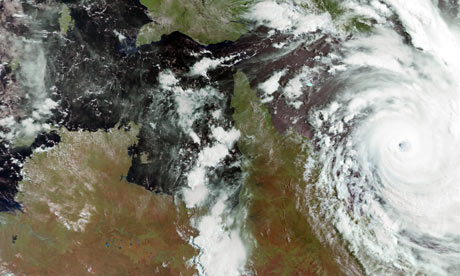 |
| Cyclone Yasi approaching the northeast coast of Australia, as captured by EUMETSAT's polar-orbiting satellite Metop-A at 2355 UTC on 2 February 2011. Photograph: Eumetsat |
I'm posting a story here from the Guardian's environment blog:


Will cyclone Yasi push Australia into action on climate?
The 'monster, killer storm' is the biggest for at least a century, with 400,000 people in its path. Will this latest extreme weather affect attitudes to global warming?
Click here to got to the story! In short he asks:
Immediate attention should be upon those in danger from Yasi. But a big question in the aftermath will be whether the battering Australia has taken from extreme weather, on top of its recent long drought, will shift the country's stubborn streak of sceptical opinion on climate change. Climate sceptics, as elsewhere, are firmly in the minority, but their viewpoint appears to have become more popular in recent years.
Following the recent general election - seen by some as the world's first climate change election - cyclone Yasi could be a tipping point for opinion, suggest observers.
Im going to link here now to an article I read 2 weeks ago from Germaine Greer :Immediate attention should be upon those in danger from Yasi. But a big question in the aftermath will be whether the battering Australia has taken from extreme weather, on top of its recent long drought, will shift the country's stubborn streak of sceptical opinion on climate change. Climate sceptics, as elsewhere, are firmly in the minority, but their viewpoint appears to have become more popular in recent years.
Following the recent general election - seen by some as the world's first climate change election - cyclone Yasi could be a tipping point for opinion, suggest observers.
Australian-born writer Germaine Greer spends three to four months every year in her home country where she runs the Cave Creek Rainforest Rehabilitation Scheme in Queensland.
What's going on in Australia is rain. British people might think that they're rain experts. Truth is that they hardly know what rain is. The kind of cold angel sweat that wets British windscreens isn't proper rain. For weeks now rain has been drumming in my ears, leaping off my corrugated steel roof, frothing through the rocks, spouting off the trees, and running, running, running past my house and down into the gully, into the little creek, into the bigger creek, and on to the Nerang river and out to sea at Southport. We've had more than 350mm in the last four days. My creek is running so high and so fast that I can't get out and my workforce can't get in. I can't even go for a walk under the dripping trees, because I'll come back festooned with leeches. In these conditions you can end up with a leech in your eye, and there's no one here to help get it out.
Continue reading here.
I will add this excerpt as I thought it very noteworthy... the comments that come at the end of the article are, in some cases,
quite heated. There was much food for thought in this article and if you did not already read it consider doing so!
The colour of the water reveals a terrible truth. What is being washed downstream is topsoil. The water moves so rapidly because so much of the land has been cleared. Any wooded land will be, like mine, high in the catchment.
As long ago as 1923, Sydney Skertchly,
an Englishman who had been working
for the Queensland government as a
geologist before he retired to what is
now the Gold Coast suburb of
Molendinar, pointed out that rain that
fell in the upper part of the Nerang rive
catchment that used to take five days
to reach him on the coastal plain at
Molendinar, now reached him in five
hours. When the settlers first arrived on the coast of northern New South Wales and southern Queensland, the rivers were navigable. As the "scrubs" (the settlers' way of referring to rainforest) were ripped out, the seasonal rains carried the topsoil into the rivers, which silted up and then began to flood.
Thats sobering .... in the Seed Lab last year talk often centred on the destruction of habitat and the consequences of that. Due to land clearing, commercial use of land, housing development, farming.... all the factors that destroy intact habitat... if heavy rain could once take 5 days to reach the coast and is now taking 5 hours... than any wonder we saw the tragic loss of life, homes and livelihood in the valley at the base of the range behind Brisbane recently!

5 comments:
Thanks Sophie for your update. I am thinking of you and your country and wishing for a calming to come.
The whole thing is overwhelming! Great post!
Hi Maggie,
Hi Mary,
so far news is a little better than we thought... still yet to see though what the outcome is.
Thank you for your warm messages!
S
It's so sad when you hear about the topsoil being washed away. Thinking of you in Australia and hoping that the rains have subsided.
Hello Elaine,
I was at a climate change and food security forum last year where a speaker talked of peak soil.... and peak fertilizer ... made it so much clearer for me how much trouble we are in with loss of topsoil at this time.
Its seems that the cyclone brought destruction a-plenty ... however ... with less impact that it was feared in the led up ...they had thought the worst and woke to a better outcome!
thanks for your messages,
S
Post a Comment